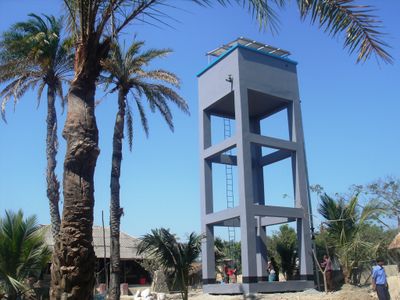Difference between revisions of "Decentralized Drinking Water Supply"
***** (***** | *****) |
***** (***** | *****) m |
||
| Line 66: | Line 66: | ||
[[Category:Productive Use|Productive_Use]] <br/> | [[Category:Productive Use|Productive_Use]] <br/> | ||
| + | |||
| + | [[Category:Productive_Use]] | ||
| + | [[Category:Solar]] | ||
| + | [[Category:Water_supply]] | ||
Revision as of 10:12, 28 September 2011
According to the WHO statistics, about 7 million people die every year due to contaminated ground water. 1.4 billion people (more than one fifth of the world population) are affected by water shortage and do not have an adequate supply of potable drinking water. People living in remote rural areas or in a suburban housing scheme in developing countries are especially affected by water shortage.
In developing countries a drinking water supply of poor quality is the root of 80% of all illnesses. Through environmental pollution, population growth and an increasing water consumption per person, it is estimated that 50% of the world population will not have enough drinking water by the year 2050. Due to these facts, water purification and an adequate potable water supply are important topics which are discussed world-wide.
In developing countries the situation is intensified due to a poor or non-existent electricity grid. However, developing countries show a prevailingly high potential for the use of renewable energy (e.g. solar, wind). Further, the decentralized electricity supply is often the more cost effective solution as compared to a grid-connected system.
On the large-scale, technologies for desalination and water disinfection are already installed in many different countries and are working reliably. For the application in rural areas of developing countries, however, the need for improvement still exists with regard to the energy supply and minimizing the maintenance requirements.
Technologies to produce clean drinking water decentrally, from renewable energy sources and for a reasonable and commercially viable price are at hand. The cost per litre is very much depending on the degree and type of contamination though. Generally it can be said that arsenic contamination is the most expencive to deal with, gladly this type of contamination only occurs in very few countries. Salty/Brackish water is in the middle range when it comes to cost for purification. Sweetwater is the cheapest, as the removal of impurities or bacteria can be done quite easily. At last of course it is cheaper to use a surface water if that is available, as deep well pumps dont have to be run.
If sweet uncontaminated groundwater can be found only very little filtering is needed. Mostly PV Pumping units for this purpose can be built locally and for low costs. A unit that delivers 30.000L of water every day can be constructed for a price of 15.000Euros. Maintainance cost is minimal and the total cost per 1000L should be somewhere between 0.5$ - 1.5$
Interestingly it IS commercially viable to consider the equipment that is used for desaster response. Even this seemingly expensive high tech equipment does produce clean water for around 1.5$ - 3$ per 1000L from biologically contaminated sources.
What better disaster response equipment could there be than the stuff that you already have in your country, and what people are already used to!? Be prepared!
Some suppliers offer high quality combined units for desalination and desinfection that can produce water for 3$-4$ from salt contaminated ground water. Pretty much the most expensive type for purification.
Small, wall-mounted Systems that appear expensive at first can be brought to health centers, schools or even households that have access to a water source. They appear expensive, but run for example from a Solar Home System they can produce enough water to SELL in the neighbourhood for 3$-6$ per 1000L.
Severeal ideas and technologies are available to provide clean drinking water on household level, that do not use any electricity. To be mentioned:
The Lifesaver bottle
The Water cone
Thermal purification panels
SODIS
Technologies:
Thermal purification processes
Distillation
example for a commercial application: Gerindtec and GIZ in south India
Thermal desalination: http://www.solarspring.de/
Electrical purification processes
Reverse osmosis
Electrodialysis
Links
Solar water purification in Laos: http://www.lao-ire.org/Programs/solar-waterpurification.html




















